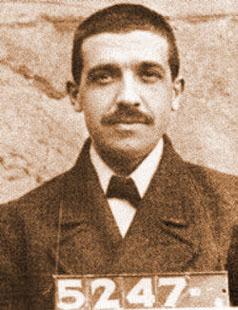Submitted by nsscadmin on

Arguably the most infamous fraudster in history, everyone knows the name Charles Ponzi. They may know the name, but that doesn’t mean they know the story behind the man who swindled thousands of people out of $20 million in the 1920s.
Originally born Carlo Pietro Giovanni Guglielmo Tebaldo Ponzi in Italy in 1882, Charles Ponzi, an Italian immigrant, lived in Boston in 1919 when he stumbled upon a money-making investment scheme: international reply coupons.
If someone was sending mail to another country that required a reply they could include an international reply coupon. This coupon that could be used to pay the return postage. The reply coupon had the value of the cost required to send mail from that country. However, the cost of sending mail varied greatly from country to country at the time.
So, for example if mailing a letter in the states cost five cents and mailing a letter in France cost 10 cents You could effectively buy reply coupons in the US for five cents and sell them for 10 cents in France, earning yourself a profit.
Through this perfectly legal form of arbitrage, Ponzi guaranteed massive profits of 100 per cent returns in 90 days, dwarfing the 5 annual returns banks were offering at the time.
Ponzi quickly found some investors. These investors were promptly paid a $750 return. As word spread, more and more investors lined up.
Only Ponzi knew, however, that the returns weren’t paid from actual investment returns, but instead from the investors own money.
As word spread that Ponzi has in effect paid his investors the mammoth returns he promised more and more investors lined up to give him their money. Ponzi used the money coming in from new investors to pay subsequent investors.
By June 1920 more than $2.5 million had been invested in Ponzi’s scheme. By the following month nearly $250,000 per day was being invested. By the time the scheme eventually collapsed, estimates have Ponzi stealing $20 million (approximately $246 million today). While millions of dollars were coming in, Ponzi was spending his investors’ money on his own lavish lifestyle.
Ponzi’s scheme fell apart when someone calculated that even $1,800 invested with Ponzi in early 1920 would require 53,000 reply coupons to produce Ponzi’s promised return. The millions of dollars invested with Ponzi by July would require 160 million reply coupons. At the time there were only 27,000 reply coupons in circulation.
Ponzi eventually went bankrupt and was arrested on August 12, 1920. Ponzi was jailed until 1934, after which, he was deported back to Italy.
Ponzi died in Brazil penniless and destitute on January 15, 1949 at the age of 66.
Can you spot the red flags of investment fraud in Charles Ponzi’s story?
1. You were promised a high return for low risk.
2. Is there a credible source that can validate the investment?
3. Are they registered? What is their background?

